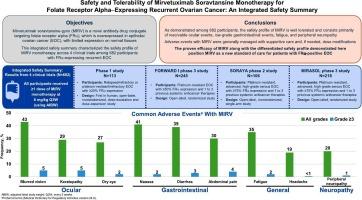Safety and tolerability of mirvetuximab soravtansine monotherapy for folate receptor alpha–expressing recurrent ovarian cancer: An integrated safety summary
IF 4.5
2区 医学
Q1 OBSTETRICS & GYNECOLOGY
引用次数: 0
Abstract
Objective
Mirvetuximab soravtansine-gynx (MIRV) is a novel antibody-drug conjugate targeting folate receptor alpha (FRα), which is overexpressed in epithelial ovarian cancer (EOC), with limited expression on normal tissues. This integrated safety summary sought to characterize the safety profile of MIRV monotherapy in participants with FRα-expressing recurrent EOC.
Methods
Safety data were retrospectively analyzed from 4 clinical studies (phase 1 trial [NCT01609556], phase 3 FORWARD I [NCT02631876], phase 2 SORAYA [NCT04296890], phase 3 MIRASOL [NCT04209855]) that evaluated participants with FRα-expressing recurrent EOC who received ≥1 dose of MIRV 6 mg/kg adjusted ideal body weight every 3 weeks.
Results
In this analysis of 682 participants, 94 % had platinum-resistant ovarian cancer (PROC). Blurred vision (43 %), nausea (41 %), diarrhea (39 %), and fatigue (35 %) were the most common treatment-emergent adverse events (TEAEs) and were primarily grade 1–2 in severity. Grade ≥ 3 TEAEs occurred in 48 % of participants, with the most common being keratopathy and blurred vision (5 % each). Most TEAEs were managed with supportive care and dose modifications, and only 12 % of participants experienced a TEAE leading to discontinuation (1 % due to ocular events). No corneal ulcerations or perforations have been reported. Median time to onset of blurred vision and keratopathy was 5.9 and 6.7 weeks, respectively. Most blurred vision events and keratopathy events resolved completely (71 % and 66 %, respectively) or partially (15 % and 14 %, respectively).
Conclusions
As demonstrated among 682 participants, the safety profile of MIRV is well tolerated and consists primarily of low-grade gastrointestinal, fatigue, headache, peripheral neuropathy, and resolvable ocular adverse events.

米韦曲单抗索拉坦星单药治疗叶酸受体α表达复发性卵巢癌的安全性和耐受性:综合安全性总结。
研究目的Mirvetuximab soravtansine-gynx(MIRV)是一种靶向叶酸受体α(FRα)的新型抗体-药物共轭物,叶酸受体α在上皮性卵巢癌(EOC)中过度表达,而在正常组织中表达有限。本综合安全性总结旨在描述MIRV单药疗法对FRα表达的复发性EOC患者的安全性特征:对4项临床研究(1期试验[NCT01609556]、3期FORWARD I [NCT02631876]、2期SORAYA [NCT04296890]、3期MIRASOL [NCT04209855])的安全性数据进行了回顾性分析,这些研究评估了每3周接受≥1个剂量的MIRV 6 mg/kg调整理想体重的FRα表达复发性EOC患者:在对 682 名参与者进行的分析中,94% 患有铂类耐药卵巢癌 (PROC)。视力模糊(43%)、恶心(41%)、腹泻(39%)和疲劳(35%)是最常见的治疗突发不良事件(TEAEs),严重程度主要为 1-2 级。48%的参与者出现了≥3级的TEAE,其中最常见的是角膜病变和视力模糊(各占5%)。大多数 TEAE 都通过支持性护理和剂量调整得到了控制,只有 12% 的参与者出现了导致停药的 TEAE(1% 是由于眼部事件)。没有角膜溃疡或穿孔的报道。出现视力模糊和角膜病变的中位时间分别为 5.9 周和 6.7 周。大多数视力模糊事件和角膜病变事件已完全(分别为 71% 和 66%)或部分(分别为 15% 和 14%)得到缓解:682名参与者的情况表明,MIRV的安全性很好,主要包括低度胃肠道、疲劳、头痛、周围神经病变和可缓解的眼部不良事件。
本文章由计算机程序翻译,如有差异,请以英文原文为准。
求助全文
约1分钟内获得全文
求助全文
来源期刊

Gynecologic oncology
医学-妇产科学
CiteScore
8.60
自引率
6.40%
发文量
1062
审稿时长
37 days
期刊介绍:
Gynecologic Oncology, an international journal, is devoted to the publication of clinical and investigative articles that concern tumors of the female reproductive tract. Investigations relating to the etiology, diagnosis, and treatment of female cancers, as well as research from any of the disciplines related to this field of interest, are published.
Research Areas Include:
• Cell and molecular biology
• Chemotherapy
• Cytology
• Endocrinology
• Epidemiology
• Genetics
• Gynecologic surgery
• Immunology
• Pathology
• Radiotherapy
 求助内容:
求助内容: 应助结果提醒方式:
应助结果提醒方式:


